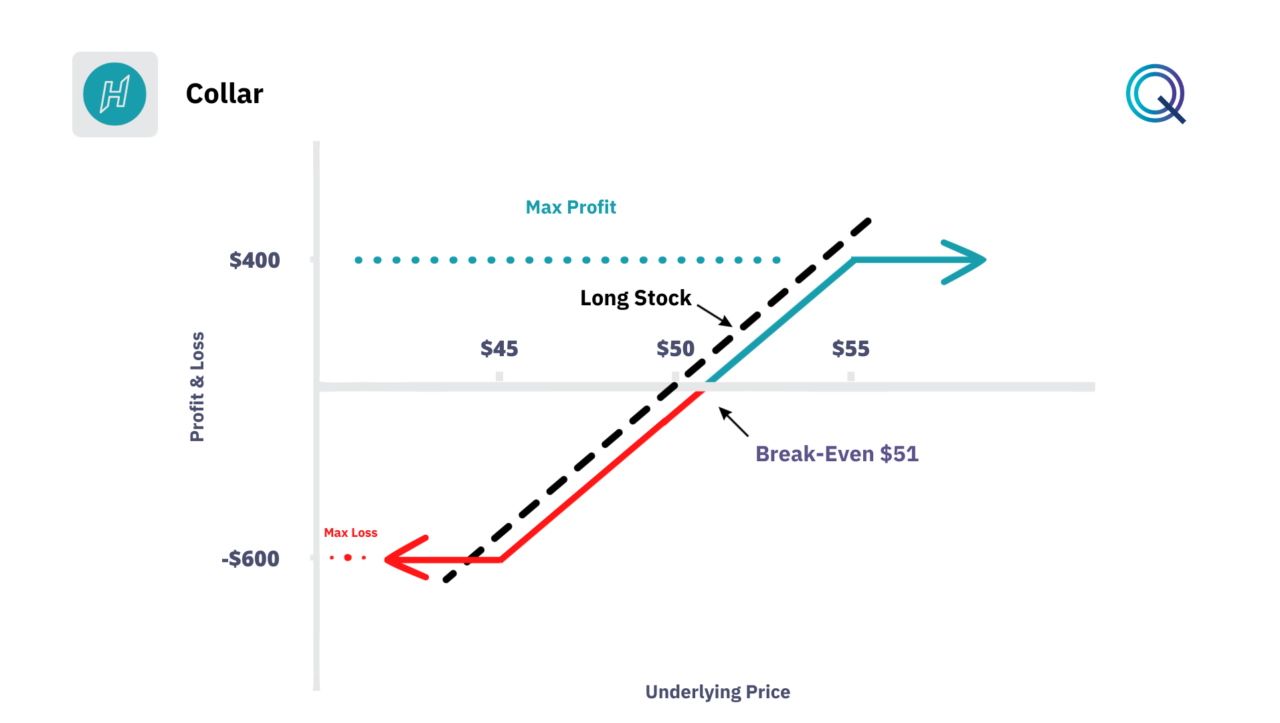Collar

Among the hedging strategies we find the Collar Strategy. The Collar is part of a series of advanced strategies with options. It is a hedging or protection strategy.
In this strategy, we have:
- A Long position on the stock or underlying asset
- An out-of-the-money Covered Call
- An out-of-the-money Put
The Collar has these characteristics:
- Possession of the Underlying. I must have the underlying in the Portfolio, such as 100 Tesla shares or 100 shares of SPY.
- Purchase of a Put for protection, or Long Put.
- Sale of an out-of-the-money call whose price is higher than the current spot price or Covered Call.
To protect an underlying asset or portfolio we have the Long Put strategy. By purchasing puts for protection, we manage to completely or partially insure and protect the portfolio. However, this protection has a cost that can sometimes be high.
In this case, the Put protects us if the price of the underlying goes down. The sale of the call helps us to receive a premium that should fully or partially pay for the purchase price of the put.
We are in this case protected in the event of a collapse and can still benefit from a potential rise up to the strike price of the sold call. The call and the put should have the same expiration, but it is not necessary in all cases. The Collar is a strategy widely used by investors who are long on shares and want to cover their risk.
Payoff Diagram of the Collar Strategy
Let’s look at the payoff of the Collar Strategy. In this example, we are Long on a stock that we purchased at $50. We hold 100 shares of this company and our exposure is $5,000.
We want to protect ourselves from a possible collapse and we buy a put with a $45 strike. At the same time, we sell an out-of-the-money call with a $55 strike. Let’s assume that the net cost of this strategy is $1 (the difference between the cost of the put and the premium received for selling the call).
The maximum profit is $400 and is calculated as follows:
[(Call Strike) +/- (Net premium i.e., premium received for selling the call – purchase cost of the put) – Cost of carrying the shares] * 100 shares.
Or: (55-1-50)*100 = $400
The maximum loss is $600 in the event the price of the underlying falls below $45 at expiration. We calculate it this way:
[Cost of carrying the shares – (Put Strike) +/- (Net premium resulting from the purchase cost of the put – premium received for selling the call)] * 100 shares
Or: (50-45+1)*100 = $600
As we can see from this example, we have almost completely financed the strategy by selling the call. This strategy allows us to limit risk, but by selling the call, we also limit the potential profit in case the underlying continues to rise.
If the price of the underlying at expiration rises above the strike of the call, we will have to deliver the 100 shares at the strike price, losing potential profits.

Variables to Consider when using a Collar
There are a few factors to consider when using a Collar:
- Dynamic Collar Adjustments. Investors may choose to dynamically adjust their Collar positions in response to market movements. If the stock rises significantly, an investor might decide to roll up the put to a higher strike, maintaining a closer level of protection to the new stock price. If the stock price falls, the investor could roll down the call strike, generating additional premium to offset paper losses.
- Tax Implications. Understanding the tax implications of employing a Collar strategy is important. The creation of a Collar can sometimes be treated as a constructive sale and this could potentially lead to tax liabilities on unrealized gains.
- Selecting Expiry Dates. The choice of expiry dates for the options in a Collar can significantly affect the risk and return profile of the strategy. Shorter-term options may require more frequent adjustments but could provide higher annualized premium income. Longer-term options can offer more extended protection with less active management but might result in lower annualized income due to time decay (theta).
- Earnings and Dividends. The presence of earnings announcements or dividend payments can impact the selection of strike prices and the timing of option sales. Investors might choose to establish a Collar before an earnings announcement as a protective measure.
- Using Index Options. Instead of applying a Collar to individual stock positions, investors can use index options to hedge a diversified portfolio. This approach can be less management-intensive and still provide broad market protection.
- Opportunity Costs. While the Collar limits downside risk, it also caps the upside potential. Investors should consider the opportunity cost of potential gains if the stock appreciates beyond the strike price of the sold call. This trade-off needs to be balanced against the protective benefits of the strategy.
- Implementing a Zero-Cost Collar. A zero-cost Collar is where the premium received from selling the call option is equal to the premium paid for the put option, resulting in no net cost to establish the hedge. While this is an attractive proposition, it may require accepting tighter bounds on potential gains and losses.
- Psychology. The psychological comfort that a Collar provides can be a double-edged sword. It can lead to complacency, where an investor might ignore fundamental changes in the underlying asset due to the perceived safety net.
We cover this in more depth in our Academy.
Conclusion
To recap:
- Collar is a Hedging Strategy
- We use this strategy to protect our risk on the underlying
- The strategy has a defined risk and profit potential
Other Hedging Strategies
Here is a list of other Hedging Strategies with options:
